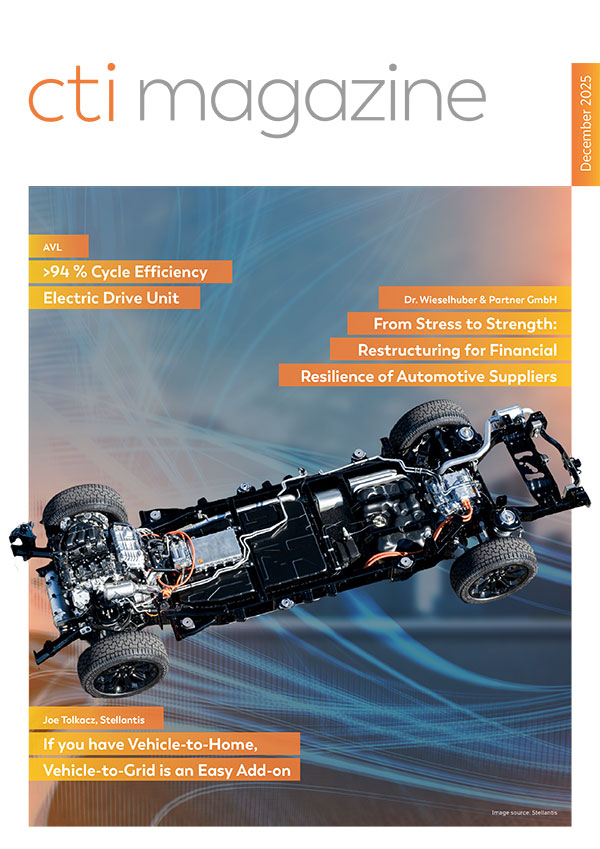
Dr Norbert Alt, COO of FEV
There is uncertainty about which drive solutions will be best in the near and longer term. In our interview, Dr Norbert Alt, COO of FEV, an innovation driver in the mobility sector, advocates a technology-open approach but with a clear commitment to electric vehicles. Hybrid BEVs are included, he says – but e-fuels will not be realistic for passenger cars in a market-relevant quantity by 2035.
Dr Alt, what do you think about the current reluctance to buy battery-electric cars?
Looking at BEV sales figures in China, the USA, and the EU, you see continuous growth and an all-time high in absolute terms. If you count BEVs, PHEVs, and REEVs together, the overall market share has grown from 22 in the first half of 2023 to 25 percent in the first half of 2024. In China, for example, New Energy Vehicles – the NEVs – have a market share of 45 percent. In Germany, we did see a decline of 16 percent for BEVs and an increase of 13 percent for PHEVs in the first half of the year. In contrast, 94 percent of new cars registered in August were electric in Norway. These are just examples. So, we should look more at international developments, not so much at ourselves in Europe. When I talk to industry stakeholders, everyone agrees that in the long term, we‘ll mainly drive electric, meaning BEVs with some PHEVs or REEVs and continuously decreasing shares of ICE in passenger cars.
How do you define REEV as being distinct from PHEV?
A while ago, we had REX, which was a Range Extender with a low-power combustion engine. Today’s REEVs – range-extended electric vehicles – have a powerful combustion engine that keeps the electric drive motor operating at full power even when the battery is low. At FEV, we actually call them Hybrid BEVs. So a Hybrid BEV / REEV should be‚ battery-electric born’, meaning it’s an electric car that we then hybridize. You can only have one vehicle platform, a BEV platform because that will be the mainstream. Hybrid BEV / REEV gives you the driving dynamics of a BEV plus additional range from the combustion engine. In China, Hybrid BEV / REEVs have a significant market share. In the spirit of technological openness, we in Europe could learn something from this. Hybrid BEVs would also help people make the transition to pure electric cars.
Interest in REEVs seems to be growing in North America, too …
Under the ACC-II Regulation of the California Air Resources Board, 35 percent of all vehicles must be ZEVs, or zero-emission vehicles, from 2026 – and 100 percent by 2035. Almost one-third of the US states are adopting this legislation. Here‘s the surprising part: Of those ZEVs, 20 percent can be hybrids, provided they have a minimum electric range of 70 miles. So basically, this opens a little window where Europe can say to the authorities: ‚Hey, look at the rest of the world; these concepts are successful in China, and they’re enshrined in law in the USA’. As engineering service providers, we always have our ears to the ground so we know what’s coming down the line. And right now, the Hybrid BEV or REEV topic is in a strongly increasing development focus. We believe that taking a similar approach as China or the USA would make more sense than unproductive debates about banning ICEs.
And what if e-fuels were to become established?
The future will be significantly electric. In Europe, we discuss using e-fuels after 2035, which, in theory, are great. But with an existing fleet of a good 1.3 billion cars worldwide, we’d need them very quickly. In the years leading up to 2035, they cannot help. It takes eight to ten years to approve and build the production
facilities. Even if we built 100 percent of the plants being discussed worldwide, the total amount of e-fuel would cover just 10 percent of German requirements – in areas outside individual mobility! Even the aviation industry is concerned about how to hit its targets. By 2032, the goal is to replace 1,2 percent of aviation fuel with sustainable e-fuels known as RFNBOs, or renewable fuels of non-biological origin’. So, we don’t see a realistic way of getting meaningful quantities of e-fuels on the road in 2035. One option not yet on the table would be similar as in US and China allowing Hybrid BEVs that burn fossil fuels and can drive 150 km electrically for example, to stay on the road longer than planned. If we were to regulate for 70 percent BEV and 30 percent Hybrid BEV, for instance, we would still be driving around 90 percent electric overall.
Moving to vehicle technology – how would you design a Hybrid BEV drive architecture?
The question is, do you want just serial, or do you want series-parallel? Obviously, engineers want the latter because you have high efficiency on the highway, too. But if one has a battery range of 150 or 200 km, maybe one can live with a purely serial drive that consumes a little more fuel at 140 or 150 km/h, which you can only do in Germany anyway. And in the city, the serial hybrid drive is 5 to 7 percent better than a conventional parallel hybrid. Also, we’re continuing our efforts to make combustion engines more efficient. We already have engines with 43 percent efficiency in production, and we’ll soon be heading for 45 percent and more.
How will electric drives and charging technology develop in the future?
There’s a clear trend towards 800V. But market penetration will be top-down for cost reasons, with 400V systems widespread in the lower sectors. In the truck sector, we’re talking about megawatt charging with even higher voltages. Another exciting development path involves optimizing the charging curve for 400V systems. The aim is to minimize losses even when fast charging to 80 percent. We are currently developing 400V systems, which you can charge from 20 to 80 percent in 19 minutes, and which are on a similar level as an 800V system. Several factors make this possible: a special cell chemistry that is well understood, an accurate battery management system, and improved heat dissipation. So, it’s not just about high charging power – you also need the smoothest possible charging curve. That’s something that offers excellent customer benefits.
What about trends in electric motors?
There is a somewhat unexpected trend here. In the past few years, motor speeds have increased – up to 30,000 rpm in the Far East. Higher speeds mean smaller motors, which is good, but also more friction, which is not good for efficiency. Some German manufacturers have now reduced EDU rpm to 13,000 and are seeing excellent consumption at 120 or 130 km/h. You only need higher rpm for sporty applications or when the package is a high priority. Another trend – one we are working on with a German company – is dual-rotor motors, which enable high efficiency at part load, high power and torque density and lower costs. And a topic the whole industry is working on is externally excited electric motors. These require no heavy rare earths and can reduce our dependencies on raw materials.
Which way is battery chemistry heading?
Nickel-manganese-cobalt (NMC) and lithium-iron-phosphate – LFP – batteries are used mainly in passenger cars, especially LFP in the cost-sensitive segment. We’re also developing sodium-ion batteries. Sodium Chloride is available in large quantities in nature, so that’s more favorable concerning raw materials. Also, sodium-ion is already not far behind LFP regarding energy density. And since Hybrid BEVs batteries require less space in a standard BEV platform, they can also cut production costs for Hybrid BEVs. Then, in the high-performance sector, we’re talking about solid state, but that will take a while. Semi-solid-state batteries will come sooner. We’re currently working with manufacturers on joint developments here.
What drive technologies do you foresee in trucks in the next few years?
Surprising as it may seem, there is also a trend towards full electrification in Europe. At the last IAA, almost all major OEMs shared that view. The trend also applies to long-haul trucks because this is an industry where TCO rules. We are talking about 30, possibly 40 percent BEV share in 2035. Hydrogen will also play a role. FEV is working with manufacturers to develop both fuel cells and hydrogen-powered combustion engines. But the majority will be battery-electric trucks. Some OEMs have allied to install 1,700 charging stations along main routes in Europe by 2027. The electric trucks and infrastructure operators are there, but we need support and commitment at the political level.
Some people say China is well ahead of Europe in BEV technology. What’s your view?
The BEV vehicles that German and European manufacturers offer today are on a high level of technology. They have good efficiency, high charging power, system design, drag coefficient, and more. On the other hand, the Chinese are ahead in battery cell technology and production know-how; they have invested strongly in the development and have better access to raw materials. But in the future, more and more processes will be sustainable, through to a circular economy. This will reduce the need to add further raw materials. That will put the issue of „who has the raw materials?“ back into perspective. What’s more, German manufacturers are spending billions on setting up battery cell production. At FEV, we have our own cell chemistry department, too – and as a development service provider, we work with the Chinese. Another topic is automation, which means ADAS systems, autonomous driving, etc. Here, some other countries are nowhere near as advanced as German manufacturers. So, from a technology perspective, the outlook is a lot brighter than some people say, and we will see continuous innovations in all areas. Additionally, one has to mention that low-cost BEVs are very important for the expected market penetration of BEVs, and the capability of the Chinese to produce on low cost is very high which is the major challenge for the European.
How could decision-makers in politics and the industry advance electric mobility?
We would like the EU to look at the regulatory approaches of the USA and China, and to use them as a model to some extent. At the moment, we are letting car owners hope they can have e-fuels in 2035. That’s not going to happen, only for a very small share of the market. We should also make a clear commitment as a tech community, saying we will drive more and more BEVs, some of them Hybrid BEVs. We should allow a defined percentage of Hybrid BEVs and stop the unhelpful discussion about the ICE ban. By 2045, we may reach the point where filling stations no longer stock fossil fuels, just bio and e-fuels. Another critical point we really need to tackle is electricity prices. You can generate electricity with a photovoltaic system for 10 cents per kWh, or even less. If people could charge their vehicle for 10 cents, electric cars would sell like hot cakes. Hybrid BEVs would benefit, too, because people would prefer electric driving whenever possible.
Interview: Gernot Goppelt
